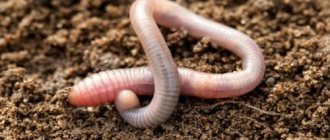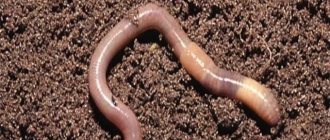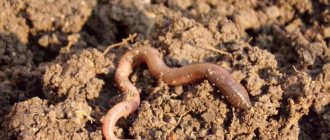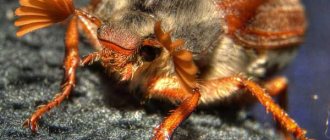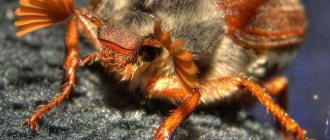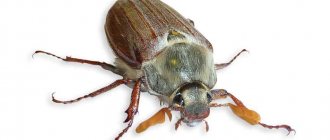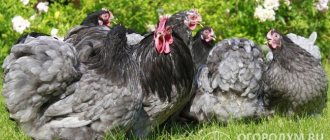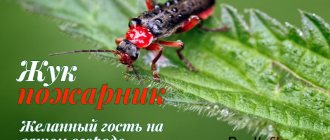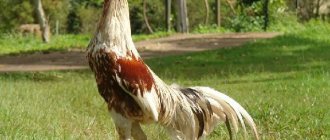External structure
Body
The earthworm, or earthworm (Fig. 51) has an elongated body, 10-16 cm long. In cross section, the body is round, but, unlike roundworms, it is divided into 110-180 segments by annular constrictions.
Each segment has 8 small elastic bristles. They are almost invisible, but if we run our fingers from the back end of the worm's body to the front, we will immediately feel them. With these bristles, the worm rests against uneven soil or the walls of the passage when moving. Regeneration in earthworms is well expressed.
Body wall
If we take a worm in our hands, we will find that its body wall is wet and covered with mucus. This mucus makes it easier for the worm to move through the soil. In addition, only through the moist body wall does the oxygen necessary for breathing penetrate into the worm’s body.
The body wall of an earthworm, like that of all annelids, consists of a thin cuticle, which is secreted by a single-layer epithelium.
Under it there is a thin layer of circular muscles, and under the circular muscles there are more powerful longitudinal muscles. By contracting, the circular muscles lengthen the body of the worm, and the longitudinal muscles shorten it. Thanks to the alternating work of these muscles, the worm moves.
Subtleties of proper care
To extend the lifespan of earthworms, they need to be properly cared for, providing comfortable conditions for development and reproductive functions. The key rules of care are to ensure a comfortable temperature, shade and stable access to food.
Professional gardeners recommend enriching compost manure with sand or crushed eggshells. Dry food is added to the soil approximately once every two weeks, but it is important to take precautions here so as not to overfeed the worms.
If you want to start breeding creatures at home, you need to remember that worms process almost everything that catches their eye. The main thing is that the products are small in size, because invertebrates do not have teeth.
Before replenishing the worm house with new food, you need to make sure that the previous organic matter is completely destroyed. If this is not the case, the animals will suffer from oversaturation and die. Leaving organic compounds in the compost will negatively impact the acidity levels, leading to deadly conditions. In addition, excess food supply contributes to the development of pests such as mites.
Caring for worms is relatively easy, but some requirements must be met. Only under such conditions will breeding a home farm bring the expected success.
Habitat
Earthworm and its movement in the soil. The anterior end of the earthworm's body from below.
During the day, earthworms stay in the soil, making tunnels in it. If the soil is soft, the worm penetrates it with the front end of its body. At the same time, he first compresses the front end of the body so that it becomes thin, and pushes it forward between the lumps of soil. Then the front end thickens, pushing the soil apart, and the worm pulls up the rear part of the body.
In dense soil, the worm can eat its way through the soil through its intestines. Lumps of soil can be seen on the surface of the soil - they are left here by worms. After heavy rain has flooded their passages, the worms are forced to crawl out to the surface of the soil (hence the name - earthworm). In summer, worms stay in the surface layers of the soil, and in winter they dig burrows up to 2 m deep.
The role of vermicompost for soil fertility
American farmers were the first to draw attention to the possibility of using earthworms for processing organic matter. They used them to obtain biomass and expand the diet of domestic animals and birds.
It has been proven that when using vermicompost, the yield of vegetables increases several times. The ripening of the crop is also accelerated by 10-15 days. All thanks to the soil that passes through the esophagus and then contains all the mineral elements and complex compounds necessary for plants. In addition, vermicompost is useful because
- reduces the number of pests in the garden,
- binds heavy metal residues and removes residual radiation,
- increases yield without the use of chemical fertilizers.
Digestive system
Internal structure of an earthworm.
Digestive, nervous, circulatory system of an earthworm. The mouth is located at the anterior end of the earthworm's body; the anus is on the back.
The earthworm feeds on rotting plant debris, which it swallows along with the soil. It can also drag fallen leaves from the surface. Food is swallowed as a result of contraction of the muscles of the pharynx. The food then enters the intestines. Undigested remains, along with soil, are expelled through the anus at the rear end of the body.
The intestines are surrounded by a network of blood capillaries, which ensures the absorption of nutrients into the blood.
№11
They are quite voracious creatures. They can eat anywhere from ½ of their body weight to their entire body weight each day. For example, if we compared their gluttony with a person, then a person with a body weight of 70 kg could eat from 35 to 70 kg of food per day.
Each earthworm can process about 4.5 kg of organic material per year.
Circulatory system
All secondary cavities have a circulatory system, starting with annelids. Its occurrence is associated with a mobile lifestyle (compared to flat and protocavitary worms). The muscles of annelids work more actively and therefore require more nutrients and oxygen, which the blood brings them.
The earthworm (Fig. 52) has two main blood vessels: the dorsal, through which blood moves from the rear end of the body to the front, and the abdominal, through which blood flows in the opposite direction. Both vessels in each segment are connected by ring vessels.
Several thick annular vessels are muscular; due to their contraction, blood moves. Muscular vessels (“hearts”) located in segments 7–11 push blood into the abdominal vessel. In the “hearts” and spinal vessels, valves prevent blood from flowing back.
From the main vessels, thinner ones depart, which then branch into the smallest capillaries. These capillaries receive oxygen through the surface of the body and nutrients from the intestines. From the capillaries that branch in the muscles, carbon dioxide and decay products are released.
Blood moves all the time through the vessels and does not mix with the cavity fluid. Such a circulatory system is called closed. Blood contains hemoglobin, which is able to carry more oxygen; she is reddish.
A closed circulatory system allows you to significantly increase your metabolic rate. In annelids it is twice as high as in flatworms, which do not have a blood pumping system.
TOP 7 benefits of earthworms in the garden?
- Earthworms normalize the natural balance of the soil, loosen and plow, significantly improving fertility and structure, and increase the amount of magnesium, phosphorus and calcium.
- When moving underground, they create tunnels through which air and moisture pass to the roots of the plants.
- They saturate the earth with oxygen and qualitatively update the chemical composition.
- They create natural organic fertilizer - bio-humus. A substance that has a beneficial effect on the development of a plant at any period of life, considered natural nutrition and protection of the plant from fungal diseases and insect pests.
- They destroy and process the remains of animals and plants, and prevent the proliferation of spores of fungal diseases.
- They are food for nocturnal inhabitants of garden plots.
- Earthworms are a good bait for swimming fish. A person uses worms strung on a fishing rod hook to catch fish in water bodies.
Having studied the features of the life of an earthworm, you need to create the proper conditions for its existence and reproduction. Earthworms are completely harmless to plants and humans, they only bring benefits to your garden plot, and if they are found in the garden, it is necessary to create all the conditions for the life and reproduction of these individuals - build compost pits and often moisten them with warm water.
Read: Why should you be friends with hedgehogs?
Join our Facebook group
Excretory system
The structure of an earthworm in longitudinal and transverse sections. Paired tubules of the excretory system are visible
The excretory system of an earthworm consists of paired tubes in each body segment (with the exception of the terminal ones) (Fig. 53).
At the end of each tube there is a funnel that opens as a whole, through which the final waste products (represented mainly by ammonia) are discharged out.
№7
As many people know, earthworms have the ability to regenerate lost segments. However, it is immediately worth noting that this ability is far from what we imagined. Since childhood, we have known that if you cut a worm into two parts, you get two new individuals. This is actually a myth. If you split the worm into two parts, the head part (the part where the head is) can survive and grow its own tail. But the tail part will not be able to grow a new head. She dies.
However, there are exceptions where the tail begins to grow new segments, but it ends up being a second tail. Accordingly, this part cannot survive and also dies. Therefore, stories that if a worm is divided into two, five, fifteen parts and new individuals will be obtained are a myth.
Nervous system
The nervous system of the earthworm (Fig. 52) is of the nodal type, consisting of a peripharyngeal nerve ring and an ventral nerve cord.
The ventral nerve cord contains giant nerve fibers that, in response to signals, cause the worm's muscles to contract. Such a nervous system ensures the coordinated work of the muscle layers associated with the digging, locomotor, feeding and sexual activity of the earthworm.
Reproduction and development
Earthworms are hermaphrodites. During the process of copulation of two individuals, mutual fertilization occurs, that is, the exchange of male gametes, after which the partners separate.
The ovaries and testes are located in different segments at the anterior end of the body. The location of the reproductive organ system is shown in Figure 51. After copulation, a belt is formed around each worm - a dense tube that secretes the cocoon shell.
The cocoon receives nutrients that the embryos will subsequently feed on. As a result of the expansion of the rings located behind the cocoon, it is pushed forward towards the head end.
At this time, 10-12 eggs are laid through the opening of the oviduct into the cocoon. Further, when the cocoon moves, sperm from the sperm receptacles received from another individual during copulation enters it, and fertilization occurs.
After this, the cocoon slides off the worm and its holes quickly close. This prevents the eggs it contains from drying out. The development of earthworms is direct, that is, they do not have larvae; a young worm hatches from the egg.
Arrangement of the worm house
If you want to start breeding earthworms at home, you need to equip a spacious worm barn in advance. The structure should become a comfortable home for the spineless, where they can live, eat and perform their biological duties.
A wooden box, a trough, an old bathtub and other similar structures can be used as a container. Experienced gardeners recommend placing high-quality open compost in the container. However, the ground must be protected with netting to prevent mass consumption of eukaryotes by birds and other natural enemies.
Proper worm care involves preparing suitable fertile soil. About 40 centimeters of compost should be placed at the bottom of the box, after which it should be filled with warm water. Next, you should create a straw bedding and wait a few days until the substances are completely absorbed. After completing these steps, you can put the worm into operation.
Finding the first group of worms to move is not difficult. It is enough to go to your own garden or vegetable garden and dig up a small layer of soil. Individuals living in the upper layers tolerate movement into the worm nest better than all others. Invertebrates are also sold in specialized gardening stores.
Settlement is carried out in several stages. The first thing a gardener needs to do is dig a small hole and then place a bucket of worms there. After this, the animals are covered with straw or burlap. In a week you will be able to notice the first results of the worms taking root.
To prevent the death of the colony, it is necessary to regularly monitor them. If the creatures demonstrate an active lifestyle, it means that they have managed to settle down normally , and everything is fine with them.
To improve adaptation to the new environment, the worms need to be fed only after 3-4 weeks. However, the heated liquid should be placed in the worm chamber at least twice a week.
